|
Scientific highlights
|
Finding flares in Kepler and TESS data with recurrent deep neural networks
Vida, K.; Bódi, A.; Szklenár, T.; Seli, B.
ADS link
|
The code is available publicly on GitHub with an example in
Colab.
Stellar flares are an important aspect of magnetic activity—from both stellar evolution and circumstellar habitability viewpoints—but automatically and accurately finding them is still a challenge to researchers in the big data era of astronomy. We present an experiment to detect flares in space-borne photometric data using deep neural networks. Using a set of artificial data and real photometric data we trained a set of neural networks, and found that the best performing architectures were the recurrent neural networks using long short-term memory layers. The best trained network detected flares over 5σ with ≥80% recall and precision and was also capable of distinguishing typical false signals (e.g., maxima of RR Lyr stars) from real flares. Testing the network—trained on Kepler data— on TESS light curves showed that the neural net is able to generalize and find flares—with similar effectiveness—in completely new data with different sampling and characteristics from those of the training set.
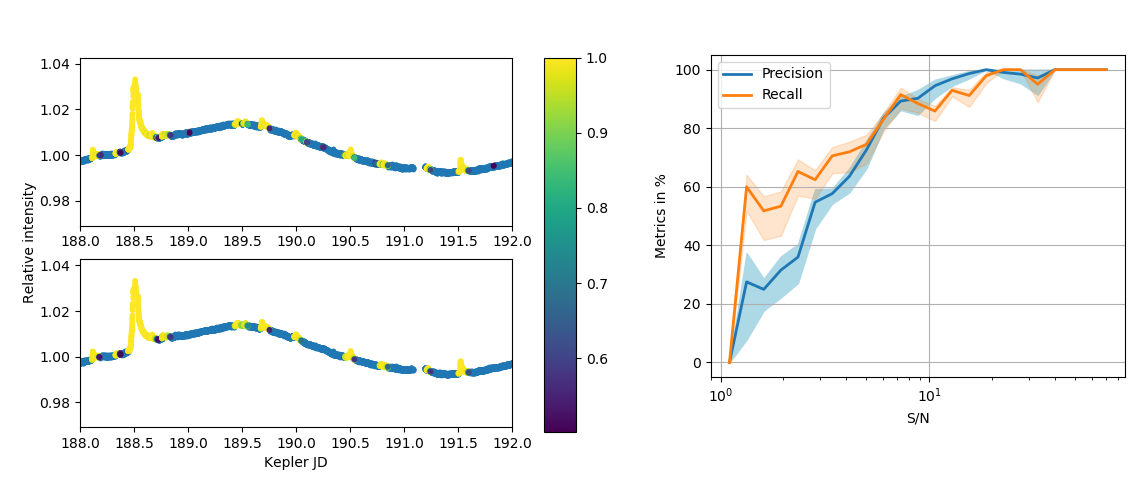 Left: The raw output of the deep neural network (top). Color-coded points show data with flare probability over 0.5. Few-point false positives can be filtered by smoothing the output with a median filter (bottom plot).
Right: Precision and recall metrics of the best neural network on an independent data set after training on Kepler data. Flare events over 5σ are recovered in 80% of the cases in the test data.
Left: The raw output of the deep neural network (top). Color-coded points show data with flare probability over 0.5. Few-point false positives can be filtered by smoothing the output with a median filter (bottom plot).
Right: Precision and recall metrics of the best neural network on an independent data set after training on Kepler data. Flare events over 5σ are recovered in 80% of the cases in the test data.
|
Can Subphotospheric Magnetic Reconnection Change the Elemental Composition in the Solar Corona?
Baker, Deborah; van Driel-Gesztelyi, Lidia; Brooks, David H.; Démoulin, Pascal; Valori, Gherardo; Long, David M.; Laming, J. Martin; To, Andy S. H.; James, Alexander W.
ADS link
|
Within the coronae of stars, abundances of those elements with low first ionization potential (FIP) often differ from their photospheric values. The coronae of the Sun and solar-type stars mostly show enhancements of low-FIP elements (the FIP effect) while more active stars such as M dwarfs have coronae generally characterized by the inverse-FIP effect (I-FIP). Here we observe patches of I-FIP effect solar plasma in AR 12673, a highly complex ¿¿¿ active region. We argue that the umbrae of coalescing sunspots, and more specifically strong light bridges within the umbrae, are preferential locations for observing I-FIP effect plasma. Furthermore, the magnetic complexity of the active region and major episodes of fast flux emergence also lead to repetitive and intense flares. The induced evaporation of the chromospheric plasma in flare ribbons crossing umbrae enables the observation of four localized patches of I-FIP effect plasma in the corona of AR 12673. These observations can be interpreted in the context of the ponderomotive force fractionation model which predicts that plasma with I-FIP effect composition is created by the refraction of waves coming from below the chromosphere. We propose that the waves generating the I-FIP effect plasma in solar active regions are generated by subphotospheric reconnection of coalescing flux systems. Although we only glimpse signatures of I-FIP effect fractionation produced by this interaction in patches on the Sun, on highly active M stars it may be the dominant process.
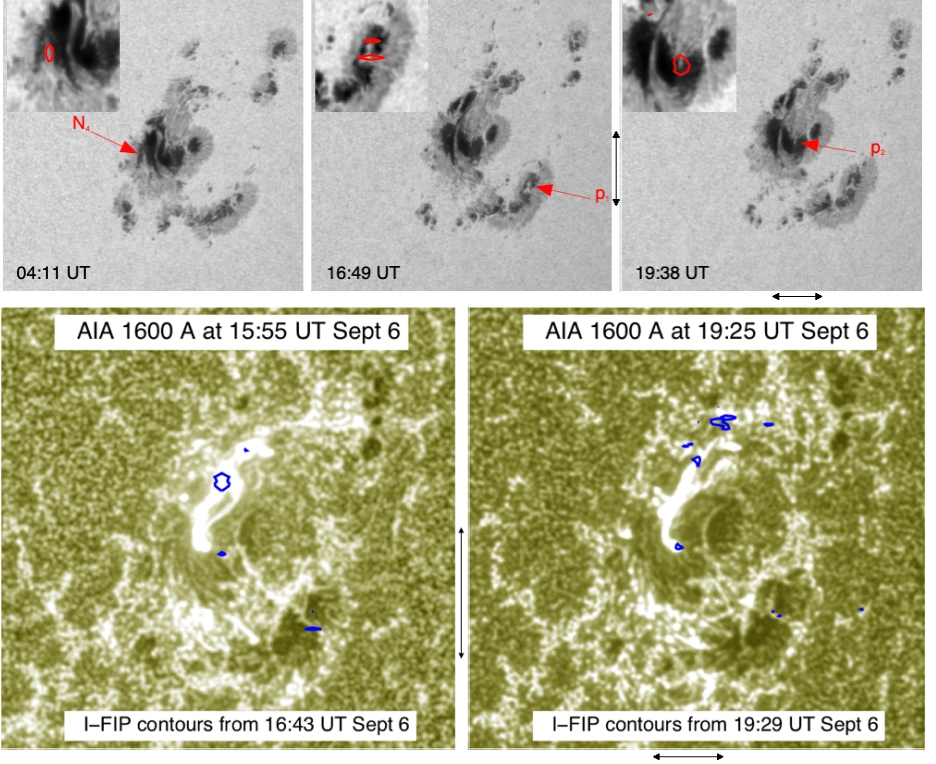 Top panel (left to right): continuum SDO/HMI images at the following timestamps: 04:11, 16:49, and 19:38 UT September 6 2017. Red arrows indicate
locations of strong light bridges. Insets are zoomed images of the light bridges overplotted with
red contours of I-FIP effect = 1.3. The I-FIP effect plasma is precisely at the locations of the strong light bridges. Bottom panel: SDO/AIA images at 1600 Å overplotted with blue I-FIP effect plasma contours.
Top panel (left to right): continuum SDO/HMI images at the following timestamps: 04:11, 16:49, and 19:38 UT September 6 2017. Red arrows indicate
locations of strong light bridges. Insets are zoomed images of the light bridges overplotted with
red contours of I-FIP effect = 1.3. The I-FIP effect plasma is precisely at the locations of the strong light bridges. Bottom panel: SDO/AIA images at 1600 Å overplotted with blue I-FIP effect plasma contours.
|
Stellar Flares from the First TESS Data Release: Exploring a New Sample of M Dwarfs
Günther, Maximilian N.; Zhan, Zhuchang; Seager, Sara; Rimmer, Paul B.; Ranjan, Sukrit; Stassun, Keivan G.; Oelkers, Ryan J.; Daylan, Tansu; Newton, Elisabeth; Kristiansen, Martti H.; Olah, Katalin; Gillen, Edward; Rappaport, Saul; Ricker, George R.; Vanderspek, Roland K.; Latham, David W.; Winn, Joshua N.; Jenkins, Jon M.; Glidden, Ana; Fausnaugh, Michael ; ..
ADS link
|
We perform a study of stellar flares for the 24,809 stars observed with 2 minute cadence during the first two months of the TESS mission. Flares may erode exoplanets' atmospheres and impact their habitability, but might also trigger the genesis of life around small stars. TESS provides a new sample of bright dwarf stars in our galactic neighborhood, collecting data for thousands of M dwarfs that might host habitable exoplanets. Here, we use an automated search for flares accompanied by visual inspection. Then, our public allesfitter code robustly selects the appropriate model for potentially complex flares via Bayesian evidence. We identify 1228 flaring stars, 673 of which are M dwarfs. Among 8695 flares in total, the largest superflare increased the stellar brightness by a factor of 16.1. Bolometric flare energies range from 1031.0 to 1036.9 erg, with a median of 1033.1 erg. Furthermore, we study the flare rate and energy as a function of stellar type and rotation period. We solidify past findings that fast rotating M dwarfs are the most likely to flare and that their flare amplitude is independent of the rotation period. Finally, we link our results to criteria for prebiotic chemistry, atmospheric loss through coronal mass ejections, and ozone sterilization. Four of our flaring M dwarfs host exoplanet candidates alerted on by TESS, for which we discuss how these effects can impact life. With upcoming TESS data releases, our flare analysis can be expanded to almost all bright small stars, aiding in defining criteria for exoplanet habitability.
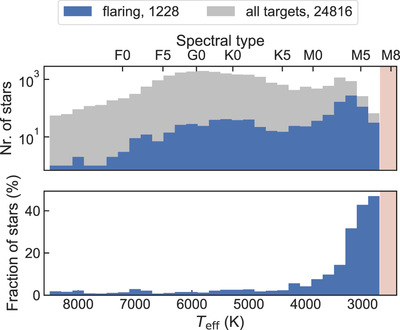
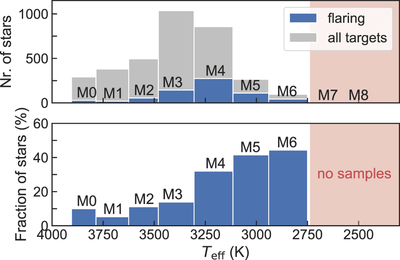 Left panel: Histograms of the number (upper panel) and fraction (lower panel) of flaring stars (blue) compared with the total number of stars (gray) in the TESS short-cadence observations of sectors 1 and 2, shown as a function of effective temperature. The top axis indicates stellar types following the classification by Pecaut & Mamajek (2013). M dwarfs dominate the sample of flaring stars, while F, G, and K stars rarely have detectable flares. For later M dwarfs, the sample size is smaller (or zero), due to the target selection.
Right panel: Zoomed in on the M dwarfs, with bins matching the stellar types following the classification by Pecaut & Mamajek (2013). Mid M dwarfs of type M4¿M6 constitute both the highest number (upper panel) and highest fraction (lower panel) of flaring stars, with up to 30% of these having flares. Earlier M dwarfs seem to flare less, showing a significantly lower fraction of 5%¿10%. Later M dwarfs were not observed in a large-enough sample size.
Left panel: Histograms of the number (upper panel) and fraction (lower panel) of flaring stars (blue) compared with the total number of stars (gray) in the TESS short-cadence observations of sectors 1 and 2, shown as a function of effective temperature. The top axis indicates stellar types following the classification by Pecaut & Mamajek (2013). M dwarfs dominate the sample of flaring stars, while F, G, and K stars rarely have detectable flares. For later M dwarfs, the sample size is smaller (or zero), due to the target selection.
Right panel: Zoomed in on the M dwarfs, with bins matching the stellar types following the classification by Pecaut & Mamajek (2013). Mid M dwarfs of type M4¿M6 constitute both the highest number (upper panel) and highest fraction (lower panel) of flaring stars, with up to 30% of these having flares. Earlier M dwarfs seem to flare less, showing a significantly lower fraction of 5%¿10%. Later M dwarfs were not observed in a large-enough sample size.
|
A census of coronal mass ejections on solar-like stars
Leitzinger, M.; Odert, P.; Greimel, R.; Vida, K.; Kriskovics, L.; Guenther, E. W.; Korhonen, H.; Koller, F.; Hanslmeier, A.; K¿vári, Zs; Lammer, H.
ADS link
|
Coronal mass ejections (CMEs) may have major importance for planetary and stellar evolution. Stellar CME parameters, such as mass and velocity, have yet not been determined statistically. So far only a handful of stellar CMEs has been detected mainly on dMe stars using spectroscopic observations. We therefore aim for a statistical determination of CMEs of solar-like stars by using spectroscopic data from the ESO phase 3 and Polarbase archives. To identify stellar CMEs, we use the Doppler signal in optical spectral lines being a signature of erupting filaments that are closely correlated to CMEs. We investigate more than 3700 h of on-source time of in total 425 dF-dK stars. We find no signatures of CMEs and only few flares. To explain this low level of activity, we derive upper limits for the non-detections of CMEs and compare those with empirically modelled CME rates. To explain the low number of detected flares, we adapt a flare power law derived from EUV data to the Hα regime, yielding more realistic results for H ¿ observations. In addition, we examine the detectability of flares from the stars by extracting Sun-as-a-star Hα light curves. The extrapolated maximum numbers of observable CMEs are below the observationally determined upper limits, which indicates that the on-source times were mostly too short to detect stellar CMEs in Hα. We conclude that these non-detections are related to observational biases in conjunction with a low level of activity of the investigated dF-dK stars.
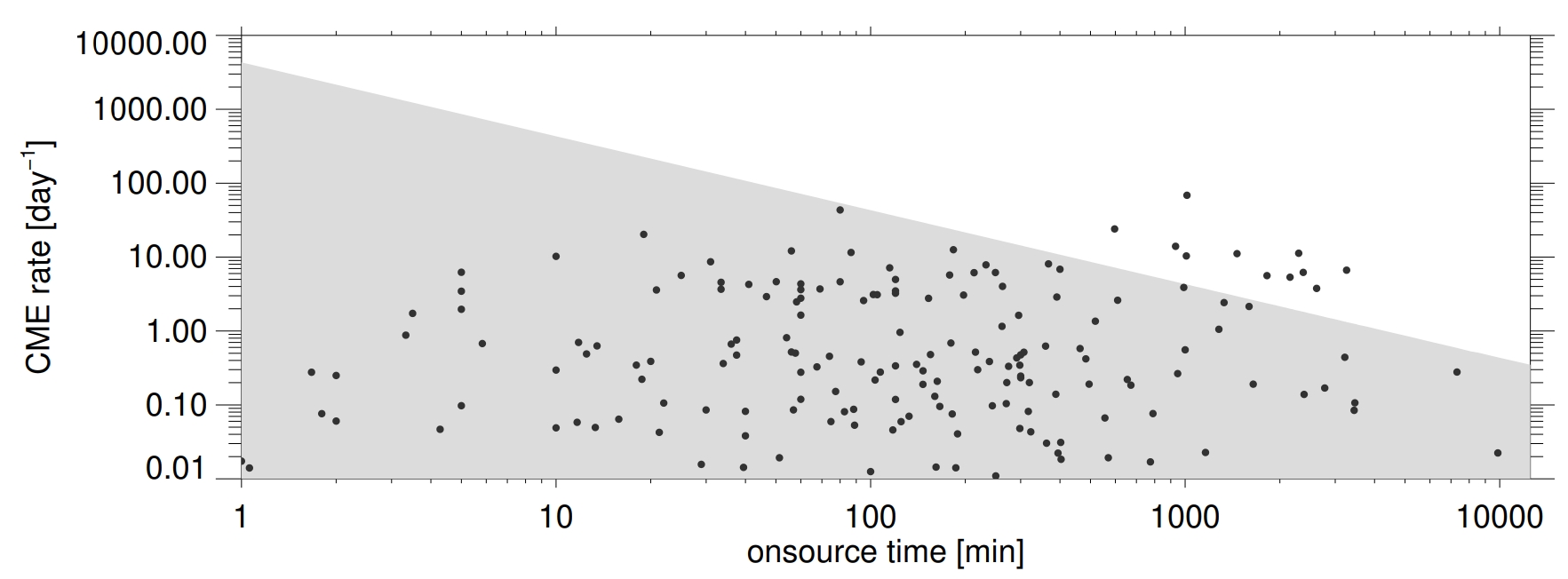 Top panel (left to right):
On-source time versus CME rate. The grey shaded area denotes the upper limits of the non detections of stellar CMEs in the
Polarbase and HARPS data. The black dots denote the maximum expected observable CME rates calculated using the semi-empirical
model of Odert et al. (2019).
Top panel (left to right):
On-source time versus CME rate. The grey shaded area denotes the upper limits of the non detections of stellar CMEs in the
Polarbase and HARPS data. The black dots denote the maximum expected observable CME rates calculated using the semi-empirical
model of Odert et al. (2019).
|
The importance of studying active giant stars in eclipsing binaries - and the role of citizen scientists in finding them
Oláh, K.; Rappaport, S.; Derekas, A.; Vanderburg, A.; Citizen Scientists: Tom Jacobs, Daryll LaCourse, Martti Kristiansen, Hans Martin Schwengeler, Ivan Terentev
ADS link
|
Red giant stars with deep convection zones and rapid rotation maintain a strong surface magnetic field which may alter their observable astrophysical parameters. The resulting lower surface temperature due to spots makes the inferred masses and ages from evolutionary tracks uncertain. Eclipsing binaries having an active giant component can help in finding the stellar mass independently.
However, until the recent space missions it was nearly impossible to find such systems from the ground. Since the evolution on the giant branch is rapid, the number of binaries containing giant stars is low. The eclipses, if the inclination allows, are very shallow, on the order of the photometric accuracy from the ground, due to the large brightness difference between a red giant primary and its solar size or smaller secondary. And, the typically acquired data from the ground are not uniform or continuous.
In this paper, a few new eclipsing binaries are presented with active giant components observed by TESS and discovered by citizen scientists, which are worthy of further studies.
 Top panel (left to right):
From left to right: example light curves of TIC 271892852, TIC 166974938
and TIC 220461013.
Top panel (left to right):
From left to right: example light curves of TIC 271892852, TIC 166974938
and TIC 220461013.
|
Deep long asymmetric occultation in EPIC 204376071
Rappaport, S.; Zhou, G.; Vanderburg, A.; Mann, A.; Kristiansen, M. H.; Oláh, K.; Jacobs, T. L.; Newton, E.; Omohundro, M. R.; LaCourse, D.; Schwengeler, H. M.; Terentev, I. A.; Latham, D. W.; Bieryla, A.; Soares-Furtado, M.; Bouma, L. G.; Ireland, M. J.; Irwin, J.
ADS link
|
We have discovered a young M star of mass 0.16 M¿ and radius 0.63 R¿, likely in the Upper Sco Association, that exhibits only a single 80 per cent deep occultation of 1-d duration. The star has frequent flares and a low-amplitude rotational modulation, but is otherwise quiet over 160 d of cumulative observation during K2 campaigns C2 and C15. We discuss how such a deep eclipse is not possible by one star crossing another in any binary or higher order stellar system in which no mass transfer has occurred. The two possible explanations we are left with are (1) orbiting dust or small particles (e.g. a disc bound to a smaller orbiting body, or unbound dust that emanates from such a body); or (2) a transient accretion event of dusty material near the corotation radius of the star. In either case, the time between such occultation events must be longer than ¿80 d. We model a possible orbiting occulter both as a uniform elliptically shaped surface (e.g. an inclined circular disc) and as a `dust sheet' with a gradient of optical depth behind its leading edge. The required masses in such dust features are then ¿3 × 1019 g and ¿1019 g, for the two cases, respectively.
|
Complex Rotational Modulation of Rapidly Rotating M Stars Observed with TESS
Zhan, Z.; Gunther, M. N.; Rappaport, S.; Oláh, K.; Mann, A.; Levine, A. M.; Winn, J.; Dai, F.; Zhou, G.; Huang, Chelsea X.; Bouma, L. G.; Ireland, M. J.; Ricker, G.; Vanderspek, R.; Latham, D.; Seager, S.; Jenkins, J.; Caldwell, D. A.; Doty, J. P.; Essack, Z.
ADS link
|
We have searched for short periodicities in the light curves of stars with T eff cooler than 4000 K made from 2-minute cadence data obtained in Transiting Exoplanet Survey Satellite sectors 1 and 2. Herein we report the discovery of 10 rapidly rotating M dwarfs with highly structured rotational modulation patterns among 371 M dwarfs found to have rotation periods less than 1 day. Starspot models cannot explain the highly structured periodic variations that typically exhibit between 10 and 40 Fourier harmonics. A similar set of objects was previously reported following K2 observations of the Upper Scorpius association. We examine the possibility that the unusual structured light curves could stem from absorption by charged dust particles that are trapped in or near the stellar magnetosphere. We also briefly explore the possibilities that the sharp structured features in the light curves are produced by extinction by coronal gas, by beaming of the radiation emitted from the stellar surface, or by occultations of spots by a dusty ring that surrounds the star. The last is perhaps the most promising of these scenarios. Most of the structured rotators display flaring activity, and we investigate changes in the modulation pattern following the largest flares. As part of this study, we also report the discovery of 17 rapidly rotating M dwarfs with rotational periods below 4 hr, of which the shortest period is 1.63 hr.
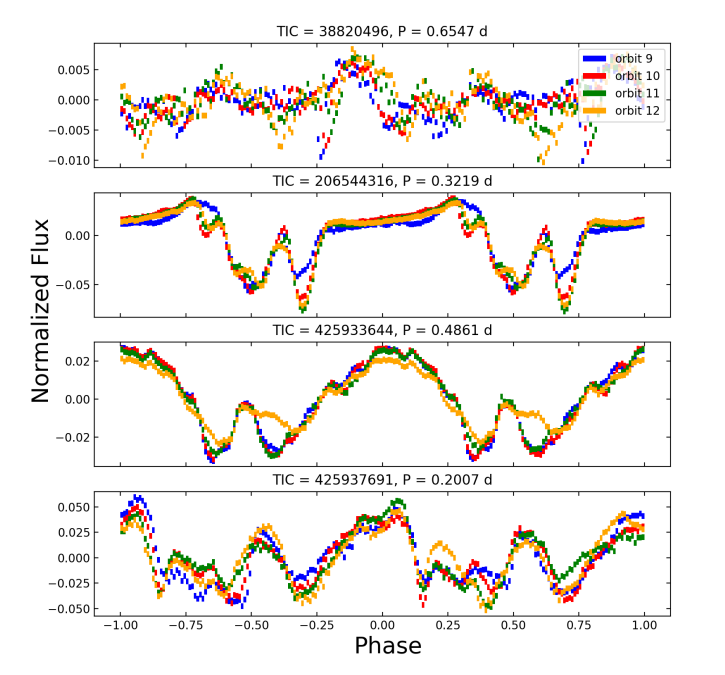
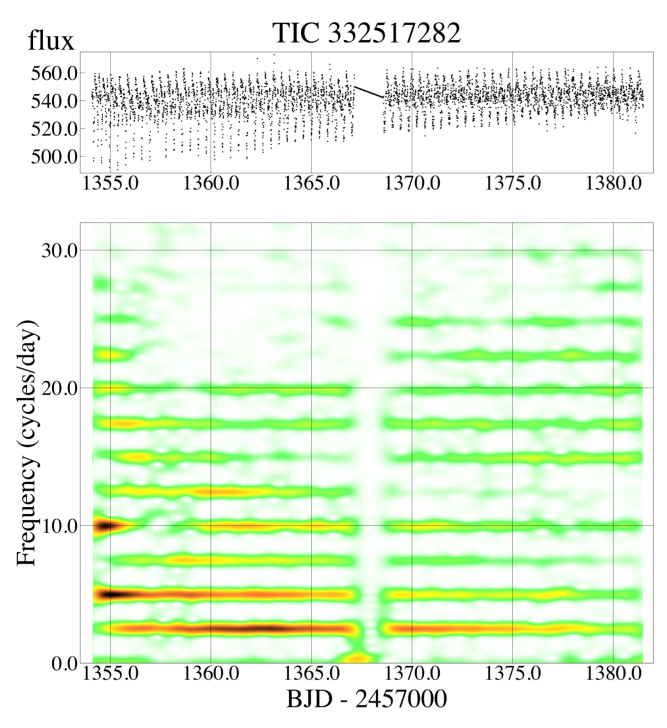 Left panel: Four examples of persistence of the rotational
modulation patterns from TESS orbit to orbit. Orbits 9 and
10 (color coded blue and red) comprise TESS Sector 1 data,
and similarly orbits 11 and 12 (green and orange) represent
Sector 2 data.
Right panel: Time-evolving Fourier amplitude spectrum for
TIC 332517282 showing the stability of the modulation frequencies.
The top panel shows the corresponding time series
during Sector 2 . The full width at half-maximum (FWHM)
of the Gaussian window is 0.94 days and the data are binned
to 7.2 min, leading to a frequency resolution and Nyquist
frequency of 1.1 cycles d-1
and 200 cycles d-1
, respectively.
The Gaussian window is stepped by ¿0.82 hours between
Fourier transforms.
Left panel: Four examples of persistence of the rotational
modulation patterns from TESS orbit to orbit. Orbits 9 and
10 (color coded blue and red) comprise TESS Sector 1 data,
and similarly orbits 11 and 12 (green and orange) represent
Sector 2 data.
Right panel: Time-evolving Fourier amplitude spectrum for
TIC 332517282 showing the stability of the modulation frequencies.
The top panel shows the corresponding time series
during Sector 2 . The full width at half-maximum (FWHM)
of the Gaussian window is 0.94 days and the data are binned
to 7.2 min, leading to a frequency resolution and Nyquist
frequency of 1.1 cycles d-1
and 200 cycles d-1
, respectively.
The Gaussian window is stepped by ¿0.82 hours between
Fourier transforms.
|
Deriving photospheric parameters and elemental abundances for a sample of stars showing the FIP effect
Seli, B.; Kriskovics, L.; Vida., K.
ADS link
|
One puzzling question in solar physics is the difference between elemental abundances in the photosphere and the corona. Elements with low first ionization potential (FIP) can be overabundant in the corona compared to the photosphere under certain circumstances. The same phenomenon has been observed on a handful of stars, while a few of them show the inverse effect. But not all the stars in the original sample had precise photospheric abundances derived from optical spectra, so for some the solar values were adopted. In this work we make homogeneous abundance measurements from optical spectroscopy. We collected spectra of 16 stars showing the FIP effect with the 1-m RCC telescope of Konkoly Observatory, with resolution of λ / Δλ ~ 21 000. We determine the fundamental astrophysical parameters (Teff, log g, [M/H], ξmic, v sin i) and individual elemental abundances with the SME spectral synthesis code using MARCS2012 model atmosphere and spectral line parameters from the Vienna Atomic Line Database (VALD).
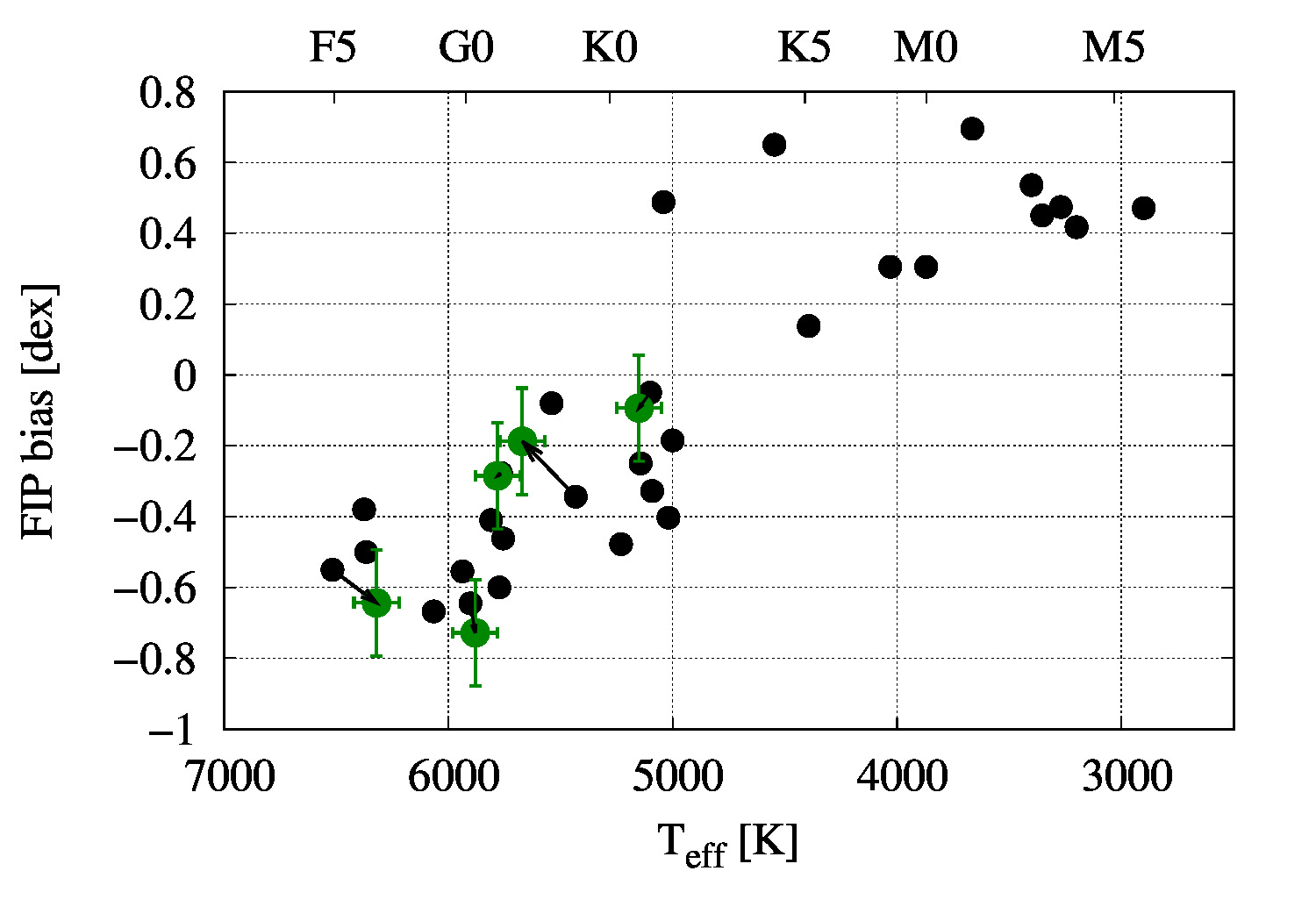 FIP bias plotted against the effective temperature. The green dots with errorbars indicate the new results.
FIP bias plotted against the effective temperature. The green dots with errorbars indicate the new results.
|
Magnetic activity of the young solar analog V1358 Orionis
Kriskovics, L.; Kővári, Zs.; Vida, K.; Oláh, K.; Carroll, T. A.; Granzer, T.
ADS link
|
Young, fast-rotating single stars can show dramatically different magnetic signatures and levels of magnetic activity as compared with the Sun. While losing angular momentum due to magnetic breaking and mass loss through stellar winds, the stars gradually spin down resulting in decreasing levels of activity. Studying magnetic activity on such solar analogues plays a key role in understanding the evolution of solar-like stars and allows a glimpse into the past of the Sun as well.
In order to widen our knowledge of the magnetic evolution of the Sun and solar-like stars, magnetic activity of the young solar analog V1358 Ori is investigated.
Fourier analysis of long-term photometric data is used to derive rotational period and activity cycle length, while spectral synthesis is applied to high-resolution spectroscopic data in order to derive precise astrophysical parameters. Doppler imaging is performed to recover surface-temperature maps for two subsequent intervals. Cross-correlation of the consecutive Doppler maps is used to derive surface differential rotation. The rotational modulation of the chromospheric activity indicators is also investigated.
An activity cycle of 1600 days is detected for V1358 Ori. Doppler imaging revealed a surface-temperature distribution dominated by a large polar cap with a few weaker features around the equator. This spot configuration is similar to other maps of young solar analogs from the literature, and supports recent model predictions. We detected solar-like surface differential rotation with a surface shear parameter of ¿ = 0.016 ± 0.010, which is in close agreement with our recently proposed empirical relation between rotation and differential rotation. The chromospheric activity indicators showed rotational modulation.
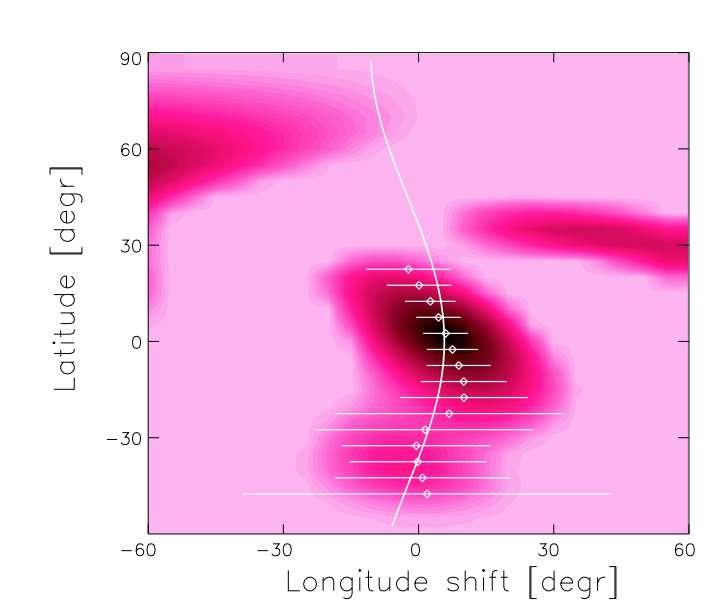 Cross-correlation function map obtained by cross-correlating the
two subsequent surface maps.. Darker regions correspond
to stronger correlation. The best fit rotation law to the correlation
peaks (dots) suggests solar-type differential rotation with a surface shear
of α = 0.016.
Cross-correlation function map obtained by cross-correlating the
two subsequent surface maps.. Darker regions correspond
to stronger correlation. The best fit rotation law to the correlation
peaks (dots) suggests solar-type differential rotation with a surface shear
of α = 0.016.
|
Surface magnetic activity of the fast-rotating G5 giant IN Comae, central star of the faint planetary nebula LoTr 5
Kővári, Zs.; Strassmeier, K. G.; Oláh, K.; Kriskovics, L.; Vida, K.; Carroll, T. A.; Granzer, T.; Ilyin, I.; Jurcsik, J.; Kővári, E.; Weber, M.
ADS link
|
On the asymptotic giant branch, low to intermediate mass stars blow away their outer envelopes, forming planetary nebulae. Dynamic interaction between the planetary nebula and its central progenitor is poorly understood. The interaction is even more complex when the central object is a binary star with a magnetically active component, as is the case for the target in this paper.
We aim to quantify the stellar surface activity of the cool binary component of IN Com and aim to explain its origin. In general, we need a better understanding of how central binary stars in planetary nebulae evolve and how this evolution could develop such magnetically active stars as IN Com.
We present a time series of 13 consecutive Doppler images covering six months in 2017 that we used to measure the surface differential rotation with a cross-correlation method. Hitherto unpublished high-precision photometric data from 1989 to 2017 are presented. We applied Fourier-transformation-based frequency analysis to both photometry and spectra. Very high resolution (R ¿ 200 000) spectra were used to update IN Com's astrophysical parameters by means of spectral synthesis.
Our time-series Doppler images show cool and warm spots coexisting with an average surface temperature contrast of -1000 K and +300 K with respect to the effective temperature. Approximately 8% of the stellar surface is covered with cool spots and ¿3% with warm spots. A consistent cool polar spot is seen in all images. The average lifetime of the cool spots is not much more than a few stellar rotations (one month), while the warm spots appear to live longer (three months) and are mostly confined to high latitudes. We found anti-solar surface differential rotation with a shear coefficient of α = -0.026 ± 0.005 suggesting an equatorial rotation period of 5.973 ± 0.008 d. We reconfirm the 5.9 day rotation period of the cool star from photometry, radial velocities, and H¿ line-profile variations. A long-term V-brightness variation with a likely period of 7.2 yr is also found. It appears in phase with the orbital radial velocity of the binary system in the sense that it is brightest at highest velocity and faintest at lowest velocity, that is, at the two phases of quadrature. We redetermine [Ba/Fe], [Y/Fe], and [Sr/Fe] ratios and confirm the overabundance of these s-process elements in the atmosphere of IN Com. Based on data obtained with the STELLA robotic observatory in Tenerife, an AIP facility jointly operated by AIP and the Instituto de Astrofisica de Canarias, and on data acquired with PEPSI using the Vatican Advanced Technology Telescope (VATT) jointly operated by AIP and the Vatican Observatory.
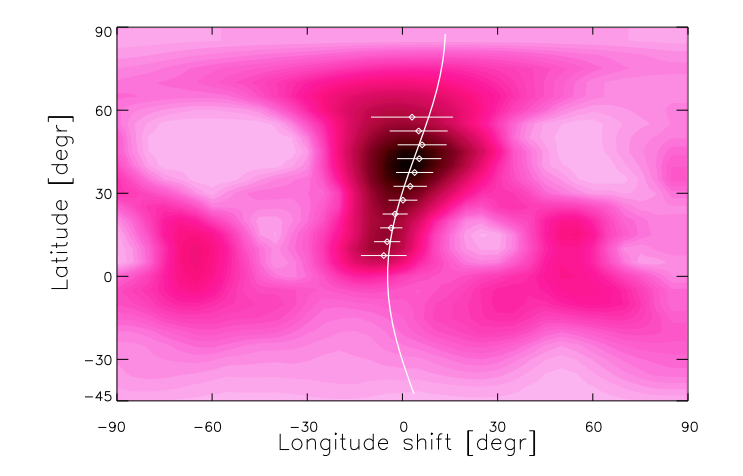 Average cross-correlation map for IN Com showing anti-solar
surface differential rotation. The best correlated dark regions are fitted
by Gaussian curves in 5 deg bins. Gaussian peaks are indicated by dots, the
corresponding Gaussian widths by horizontal lines. The best fit differential
rotation law suggests an equatorial period of Peq = 5.973 d and a
surface shear coefficient of α = -0.026.
Average cross-correlation map for IN Com showing anti-solar
surface differential rotation. The best correlated dark regions are fitted
by Gaussian curves in 5 deg bins. Gaussian peaks are indicated by dots, the
corresponding Gaussian widths by horizontal lines. The best fit differential
rotation law suggests an equatorial period of Peq = 5.973 d and a
surface shear coefficient of α = -0.026.
|
The quest for stellar coronal mass ejections in late-type stars. I. Investigating Balmer-line asymmetries of single stars in Virtual Observatory data
Vida, K.; Leitzinger, M.; Kriskovics, L.; Seli, B.; Odert, P.; Kovács, O.; Korhonen, H.; van Driel-Gesztelyi, L.
ADS link
|
Flares and coronal mass ejections (CMEs) can have deleterious effects on their surroundings: they can erode or completely destroy atmospheres of orbiting planets over time and also have high importance in stellar evolution. Most of the CME detections in the literature are single events found serendipitously sparse for statistical investigation.
We aimed to gather a large amount of spectral data of M-dwarfs to drastically increase the number of known events to make statistical analysis possible in order to study the properties of potential stellar CMEs.
Using archival spectral data we investigated asymmetric features of Balmer-lines, which could indicate the Doppler-signature of ejected material.
Of more than 5500 spectra we find 478 that have line asymmetries - including nine larger events, in terms of velocity and mass - on 25 objects, with 1.2-19.6 events per day on objects with line asymmetries. Most events are connected with enhanced peaks of Balmer-lines, indicating that these are connected to flares similar to solar events. In most cases the detected speed does not reach surface escape velocity: the typical observed maximum velocities are on the order of 100-300 km s-1, while the typical masses of the ejecta were on the order of 1015-1018 g. Statistical analysis of the events suggests that these events are more frequent on cooler stars with stronger chromospheric activity.
If the detected events correspond to CMEs, the detected maximum velocities are lower than those observed on the Sun, while event rates were somewhat lower than we could expect from the solar case. If the velocities are not distorted significantly due to a projection effect, these findings may support the idea that most of the coronal mass ejections could be suppressed by a strong magnetic field. Alternatively, it is possible that we can observe only an early low-coronal phase of the events before being accelerated at higher altitudes. Our findings could indicate that later-type, active dwarfs could be a safer environment for exoplanetary systems CME-wise than previously thought, and atmosphere loss due to radiation effects would play a stronger role in exoplanetary atmosphere evolution than CMEs.
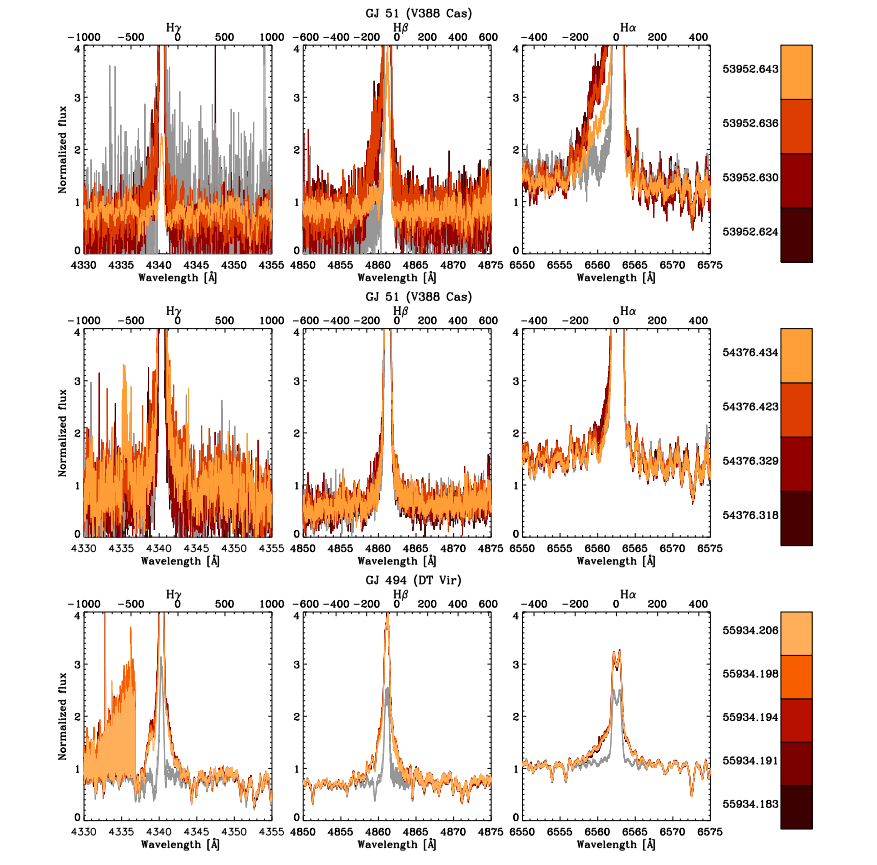 Notable events in the Balmer-lines. Bottom plots show the same spectra zoomed in. Spectra outside the event are shown in grey for
comparison.
Notable events in the Balmer-lines. Bottom plots show the same spectra zoomed in. Spectra outside the event are shown in grey for
comparison.
|
Finding flares in Kepler data using machine-learning tools
Vida, K.; Roettenbacher, R.
ADS link
|
Archives of long photometric surveys, such as the Kepler database, are a great basis for studying flares. However, identifying the flares is a complex task; it is easily done in the case of single-target observations by visual inspection, but is nearly impossible for several year-long time series for several thousand targets. Although automated methods for this task exist, several problems are difficult (or impossible) to overcome with traditional fitting and analysis approaches.
We introduce a code for identifying and analyzing flares based on machine-learning methods, which are intrinsically adept at handling such data sets.
We used the RANSAC (RANdom SAmple Consensus) algorithm to model light curves, as it yields robust fits even in the case of several outliers, such as flares. The light curves were divided into search windows, approximately on the order of the stellar rotation period. This search window was shifted over the data set, and a voting system was used to keep false positives to a minimum: only those flare candidate points were kept that were identified as a flare in several windows.
Results: The code was tested on short-cadence K2 observations of TRAPPIST-1 and on long-cadence Kepler data of KIC 1722506. The detected flare events and flare energies are consistent with earlier results from manual inspections.
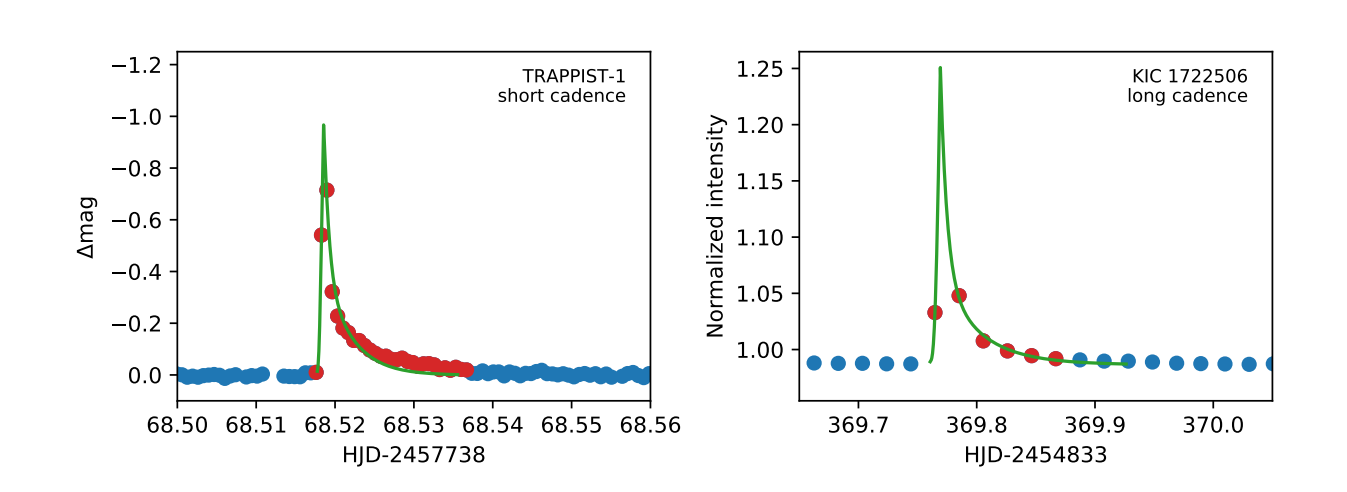 Two samples from the recovered flares, from the short-cadence TRAPPIST-1 and the long-cadence KIC 1722506 data. Red points show
the points selected for flares, the green line indicates the fitted analytical model from Davenport et al. (2014).
Two samples from the recovered flares, from the short-cadence TRAPPIST-1 and the long-cadence KIC 1722506 data. Red points show
the points selected for flares, the green line indicates the fitted analytical model from Davenport et al. (2014).
|
Eclipsing spotted giant star with K2 and historical photometry
Oláh, K.; Rappaport, S.; Borkovits, T.; Jacobs, T.; Latham, D.; Bieryla, A.; Bíró, I. B.; Bartus, J.; Kővári, Zs.; Vida, K.; Vanderburg, A.; LaCourse, D.; Csányi, I.; Bakos, G. Á.; Bhatti, W.; Csubry, Z.; Hartman, J.; Omohundro, M.
ADS link
|
Stars can maintain their observable magnetic activity from the pre-main sequence (PMS) to the tip of the red giant branch. However, the number of known active giants is much lower than active stars on the main sequence (MS) since the stars spend only about 10% of their MS lifetime on the giant branch. Due to their rapid evolution it is difficult to estimate the stellar parameters of giant stars. A possibility for obtaining more reliable stellar parameters for an active giant arises when it is a member of an eclipsing binary system.
We have discovered EPIC 211759736, an active spotted giant star in an eclipsing binary system during the Kepler K2 Campaign 5. The eclipsing nature allows us to much better constrain the stellar parameters than in most cases of active giant stars.
Methods: We have combined the K2 data with archival HATNet, ASAS, and DASCH photometry, new spectroscopic radial velocity measurements, and a set of follow-up ground-based BVRCIC photometric observations, to find the binary system parameters as well as robust spot models for the giant at two different epochs.
We determined the physical parameters of both stellar components and provide a description of the rotational and long-term activity of the primary component. The temperatures and luminosities of both components were examined in the context of the Hertzsprung-Russell diagram. We find that both the primary and the secondary components deviate from the evolutionary tracks corresponding to their masses in the sense that the stars appear in the diagram at lower masses than their true masses.
We further evaluate the proposition that traditional methods generally result in higher masses for active giants than what is indicated by stellar evolution tracks in the HR diagram. A possible reason for this discrepancy could be a strong magnetic field, since we see greater differences in more active stars. Data presented in this paper are based on observations obtained at the HAT station at the Submillimeter Array of SAO, and the HAT station at the Fred Lawrence Whipple Observatory of SAO.
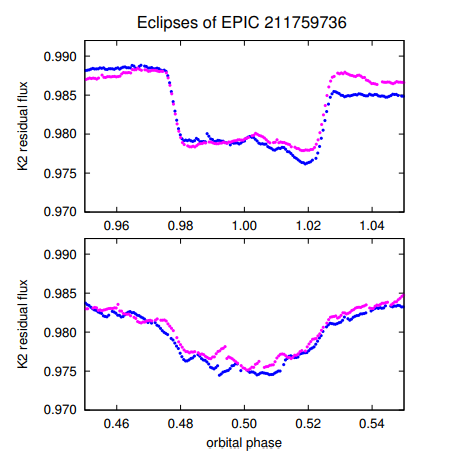 The two eclipses of EPIC 211759736 from C5, from the
first (blue) and second (magenta) rotations with the rotational
modulation removed. Phases were calculated using the time of
primary minimum and the orbital period. Top: primary
minimum (giant eclipses secondary), bottom: secondary
minimum (secondary star transits the giant).
The two eclipses of EPIC 211759736 from C5, from the
first (blue) and second (magenta) rotations with the rotational
modulation removed. Phases were calculated using the time of
primary minimum and the orbital period. Top: primary
minimum (giant eclipses secondary), bottom: secondary
minimum (secondary star transits the giant).
|
Coronal Elemental Abundances in Solar Emerging Flux Regions
Baker, D.; Brooks, D. H.; van Driel-Gesztelyi, L.; James, A. W.; Démoulin, P.; Long, D. M.; Warren, H. P.; Williams, D. R.
ADS link
|
The chemical composition of solar and stellar atmospheres differs from the composition of their photospheres. Abundances of elements with low first ionization potential (FIP) are enhanced in the corona relative to high-FIP elements with respect to the photosphere. This is known as the FIP effect and it is important for understanding the flow of mass and energy through solar and stellar atmospheres. We used spectroscopic observations from the Extreme-ultraviolet Imaging Spectrometer on board the Hinode observatory to investigate the spatial distribution and temporal evolution of coronal plasma composition within solar emerging flux regions inside a coronal hole. Plasma evolved to values exceeding those of the quiet-Sun corona during the emergence/early-decay phase at a similar rate for two orders of magnitude in magnetic flux, a rate comparable to that observed in large active regions (ARs) containing an order of magnitude more flux. During the late-decay phase, the rate of change was significantly faster than what is observed in large, decaying ARs. Our results suggest that the rate of increase during the emergence/early-decay phase is linked to the fractionation mechanism that leads to the FIP effect, whereas the rate of decrease during the later decay phase depends on the rate of reconnection with the surrounding magnetic field and its plasma composition.
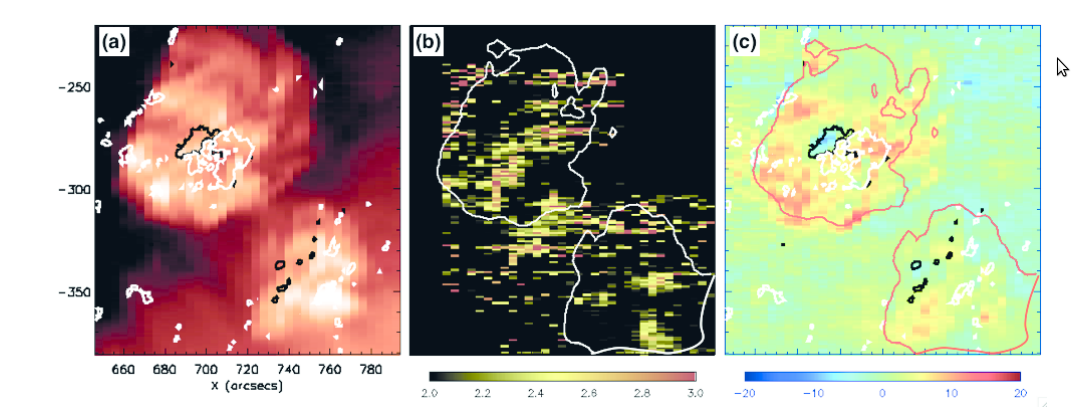 Hinode/EIS Fe XII 195 A intensity map overlaid with ± 100 G magnetic flux contours (a), composition map (b)
showing only FIP bias values greater than 2 overlaid with contours of the masks determined using the intensity threshold
method, and Fe XII 195 A Doppler velocity map (c) overlaid with magnetic flux and mask contours. Regions
1 and 2 at 13:09 on 7 January. Estimated uncertainties within the composition map is ±0.3 per pixel (see Section 3.2).
Hinode/EIS Fe XII 195 A intensity map overlaid with ± 100 G magnetic flux contours (a), composition map (b)
showing only FIP bias values greater than 2 overlaid with contours of the masks determined using the intensity threshold
method, and Fe XII 195 A Doppler velocity map (c) overlaid with magnetic flux and mask contours. Regions
1 and 2 at 13:09 on 7 January. Estimated uncertainties within the composition map is ±0.3 per pixel (see Section 3.2).
|
Rotation-differential rotation relationships for late-type single and binary stars from Doppler imaging
Kővári, Zs.; Oláh, K.; Kriskovics, L.; Vida, K.; Forgács-Dajka, E.; Strassmeier, K. G.
ADS link
|
From our sample of spotted late-type stars showing surface differential rotation, we find that the relationship between the rotation period and the surface shear coefficient α = ΔΩ/Ωeq is significantly different for single stars compared to members in close binaries. Single stars follow a general trend that ¿ increases with the rotation period. However, differential rotation of stars in close binary systems shows much weaker dependence on the rotation, if any, suggesting that in such systems, tidal forces operate as a controlling mechanism of differential rotation.
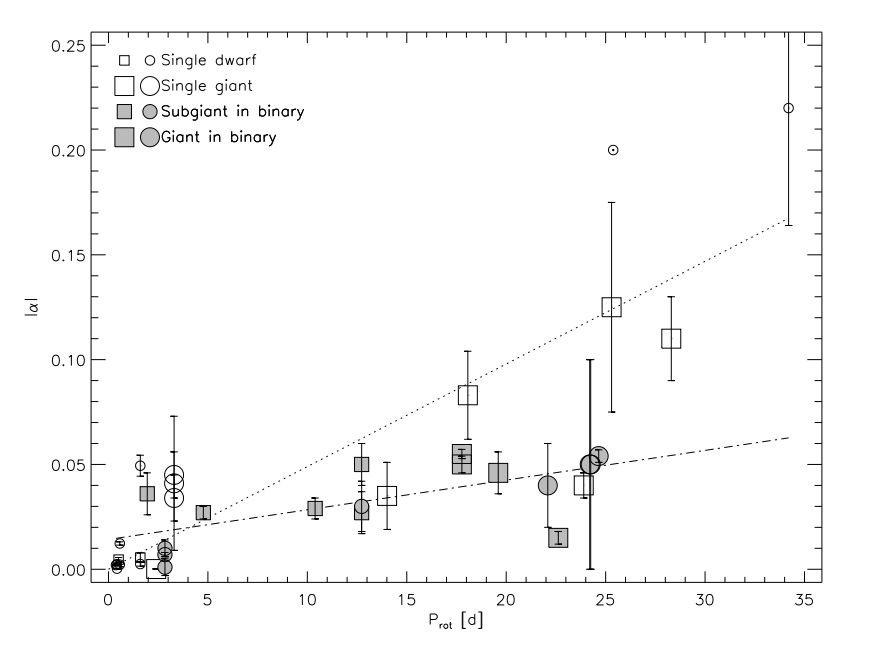 The absolute values of the dimensionless surface shear parameter α vs. rotation period. Open symbols
are single stars, grey-filled symbols are members of close binary systems. Circles represent results by applying the sheared
image method while rectangles are results obtained from cross-correlation technique. Dotted line represents a linear fit to
the single stars while dash-dotted line fits the binary members of our sample.
The absolute values of the dimensionless surface shear parameter α vs. rotation period. Open symbols
are single stars, grey-filled symbols are members of close binary systems. Circles represent results by applying the sheared
image method while rectangles are results obtained from cross-correlation technique. Dotted line represents a linear fit to
the single stars while dash-dotted line fits the binary members of our sample.
|
Antisolar differential rotation with surface lithium enrichment on the single K-giant V1192 Orionis
Kővári, Zs.; Strassmeier, K. G.; Carroll, T. A.; Oláh, K.; Kriskovics, L.; Kővári, E.; Kovács, O.; Vida, K.; Granzer, T.; Weber, M.
ADS link
|
Stars with about 1-2 solar masses at the red giant branch (RGB) represent an intriguing period of stellar evolution, I.e. when the convective envelope interacts with the fast-rotating core. During these mixing episodes freshly synthesized lithium can come up to the stellar surface along with high angular momentum material. This high angular momentum may alter the surface rotation pattern.
The single rapidly rotating K-giant V1192 Ori is revisited to determine its surface differential rotation, lithium abundance, and basic stellar properties such as a precise rotation period. The aim is to independently verify the antisolar differential rotation of the star and possibly find a connection to the surface lithium abundance.
We applied time-series Doppler imaging to a new multi-epoch data set. Altogether we reconstructed 11 Doppler images from spectroscopic data collected with the STELLA robotic telescope between 2007-2016. We used our inversion code iMap to reconstruct all stellar surface maps. We extracted the differential rotation from these images by tracing systematic spot migration as a function of stellar latitude from consecutive image cross-correlations.
The position of V1192 Ori in the Hertzsprung-Russell diagram suggests that the star is in the helium core-burning phase just leaving the RGB bump. We measure A(Li)NLTE = 1.27, I.e. a value close to the anticipated transition value of 1.5 from Li-normal to Li-rich giants. Doppler images reveal extended dark areas arranged quasi-evenly along an equatorial belt. No cool polar spot is found during the investigated epoch. Spot displacements clearly suggest antisolar surface differential rotation with α = - 0.11 u 0.02 shear coefficient.
Conclusions: The surface Li enrichment and the peculiar surface rotation pattern may indicate a common origin. Based on data obtained with the STELLA robotic observatory in Tenerife, an AIP facility jointly operated by AIP and IAC.
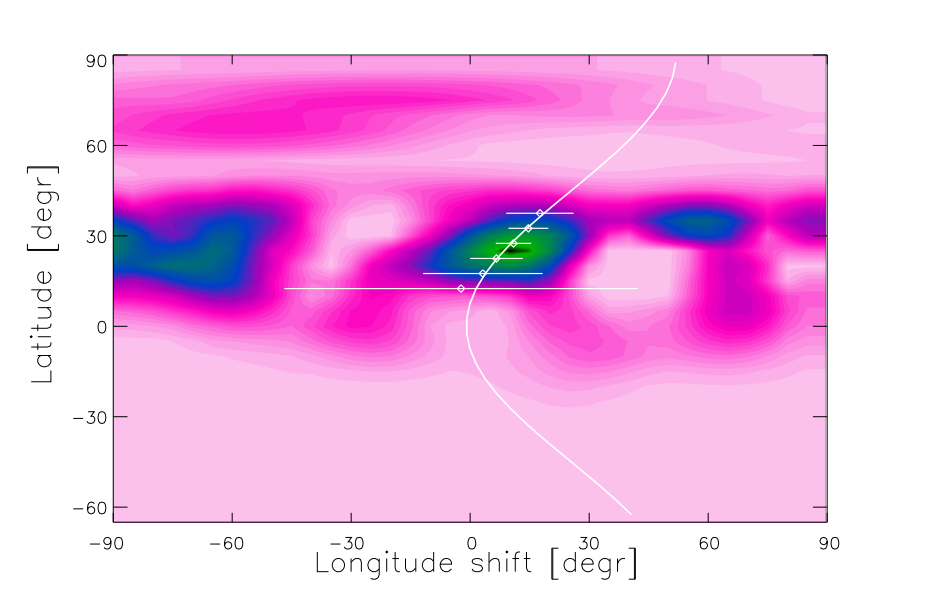
Average cross-correlation map showing the evidence for surface
differential rotation. Darker regions represent better correlation.
The average longitudinal cross-correlation functions in 5 deg bins are fitted
by Gaussian curves. Gaussian peaks are indicated by dots and the corresponding
Gaussian widths by horizontal lines. The continuous line is
the best fit, suggesting antisolar differential rotation with Peq = 28.35 d
equatorial period and α = ¿0.11 surface shear.
|
A Solar cycle correlation of coronal element abundances in Sun-as-a-star observations
Brooks, D. H.; Baker, D.; van Driel-Gesztelyi, L.; Warren, H. P.
ADS link
|
The elemental composition in the coronae of low-activity solar-like stars appears to be related to fundamental stellar properties such as rotation, surface gravity, and spectral type. Here we use full-Sun observations from the Solar Dynamics Observatory, to show that when the Sun is observed as a star, the variation of coronal composition is highly correlated with a proxy for solar activity, the F10.7 cm radio flux, and therefore with the solar cycle phase. Similar cyclic variations should therefore be detectable spectroscopically in X-ray observations of solar analogs. The plasma composition in full-disk observations of the Sun is related to the evolution of coronal magnetic field activity. Our observations therefore introduce an uncertainty into the nature of any relationship between coronal composition and fixed stellar properties. The results highlight the importance of systematic full-cycle observations for understanding the elemental composition of solar-like stellar coronae.
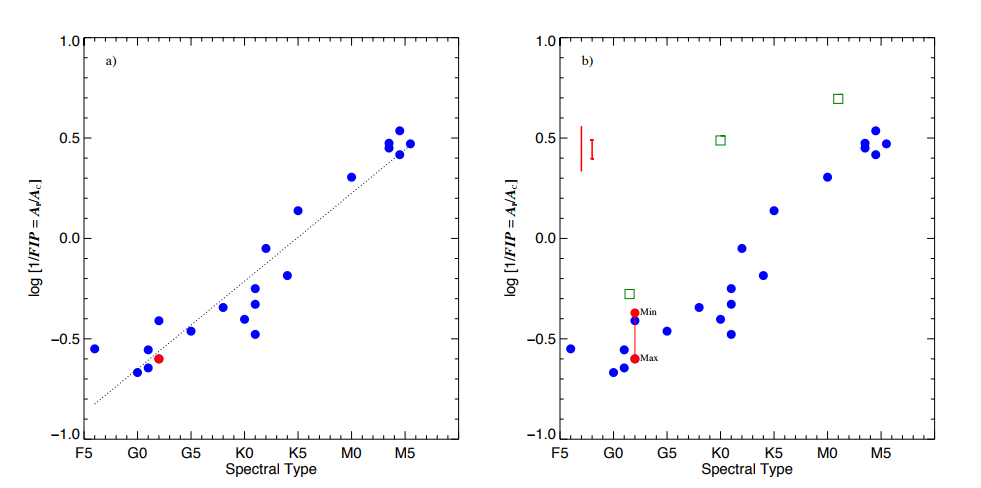 Photospheric to coronal abundance ratios as a function of spectral type for a sample
of stars. a Logarithm of the ratio of photospheric to coronal abundance for a sample of stars as a
function of spectral type. The data are adapted from Table 2 of Laming¿s review. We show the
Sun as a red dot. Note that the stellar values of Ac/Ap represent the average of the high first
ionization potential (FIP) elements C, N, O, and Ne, whereas our measurements of Ac/Ap are based
on Ne alone. The absolute values therefore may not be directly comparable. b We show the range of
values for the Sun due to the solar-cycle variation. The solid red line shows the range of movement
covered by the EVE (Extreme-ultraviolet Variability Experiment) measurements. We also show the
same range of cyclic movement plotted as a solid bar in the top left for comparison with the stellar
measurements. The smaller error bar is the uncertainty in our composition measurements. This is
the dispersion (standard deviation) in Ac/Ap computed from variations in the best fits to the
irradiance data from a large number of random trials. The
green squares are three very active stars (AB Dor, AU Mic, and EK Dra) that have been excluded
from similar plots in the past.
Photospheric to coronal abundance ratios as a function of spectral type for a sample
of stars. a Logarithm of the ratio of photospheric to coronal abundance for a sample of stars as a
function of spectral type. The data are adapted from Table 2 of Laming¿s review. We show the
Sun as a red dot. Note that the stellar values of Ac/Ap represent the average of the high first
ionization potential (FIP) elements C, N, O, and Ne, whereas our measurements of Ac/Ap are based
on Ne alone. The absolute values therefore may not be directly comparable. b We show the range of
values for the Sun due to the solar-cycle variation. The solid red line shows the range of movement
covered by the EVE (Extreme-ultraviolet Variability Experiment) measurements. We also show the
same range of cyclic movement plotted as a solid bar in the top left for comparison with the stellar
measurements. The smaller error bar is the uncertainty in our composition measurements. This is
the dispersion (standard deviation) in Ac/Ap computed from variations in the best fits to the
irradiance data from a large number of random trials. The
green squares are three very active stars (AB Dor, AU Mic, and EK Dra) that have been excluded
from similar plots in the past.
|
Frequent Flaring in the TRAPPIST-1 System - Unsuited for Life?
Vida, K.; Kővári, Zs.; Pál, A.; Oláh, K.; Kriskovics, L.
ADS link
|
We analyze the K2 light curve of the TRAPPIST-1 system. The Fourier analysis of the data suggests Prot = 3.295±0.003 days. The light curve shows several flares, of which we analyzed 42 events with integrated flare energies of 1.26×1030–1.23×1033 erg. Approximately 12% of the flares were complex, multi-peaked eruptions. The flaring and the possible rotational modulation shows no obvious correlation. The flaring activity of TRAPPIST-1 probably continuously alters the atmospheres of the orbiting exoplanets, which makes these less favorable for hosting life.
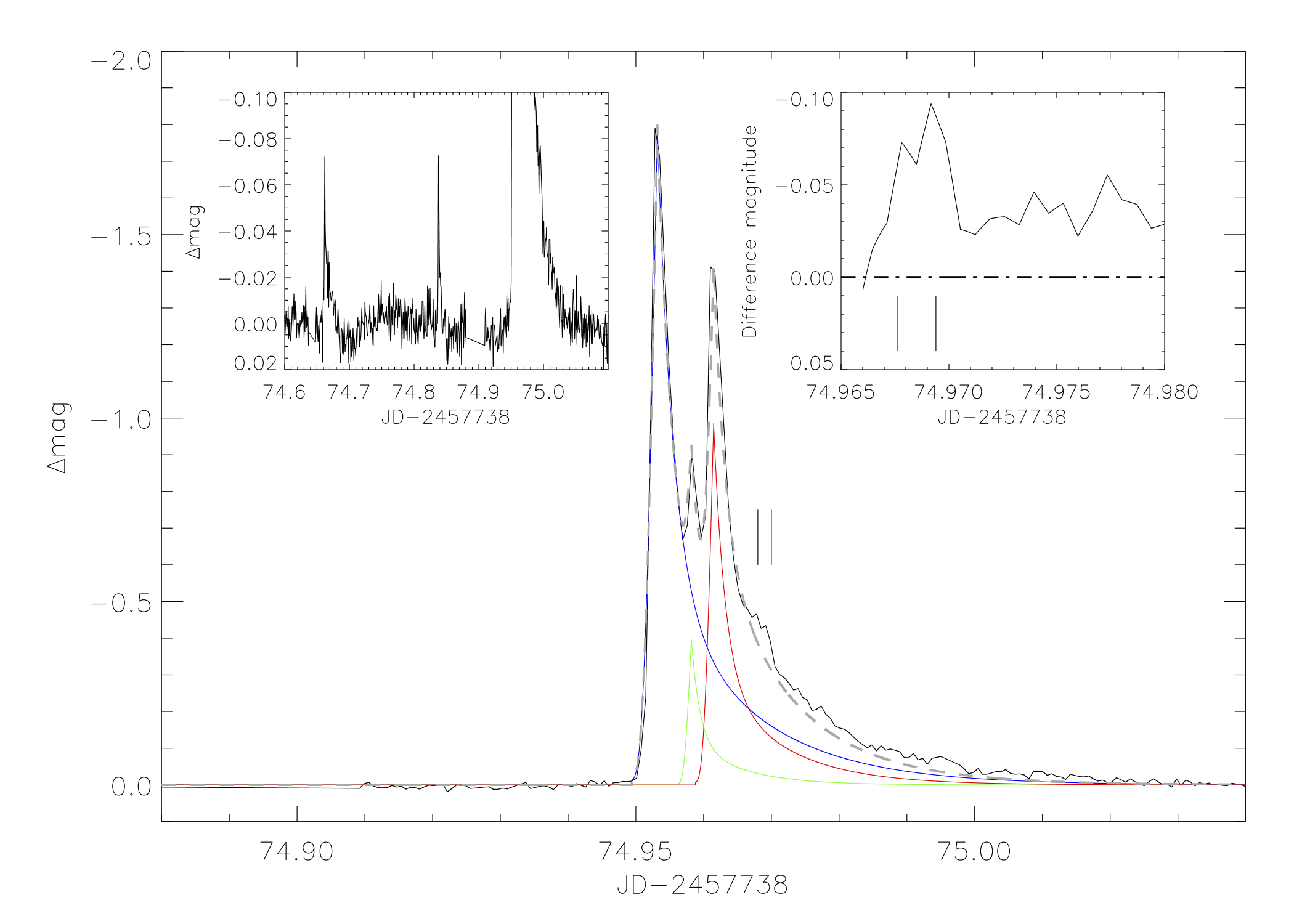 Complex flare event on TRAPPIST-1. The inset on the left shows the two earlier eruptions that could be connected with the large flare, while the one on the right shows two further possible eruptions after subtracting an analytical fit.
The frequent strong flares of TRAPPIST-1 are probably disadvantageous for hosting life on the orbiting exoplanets, as the atmospheres of the exoplanets are constantly altered and cannot return to a steady state, however this magnetic activity does not necessarily rule out the possibility of life.
Complex flare event on TRAPPIST-1. The inset on the left shows the two earlier eruptions that could be connected with the large flare, while the one on the right shows two further possible eruptions after subtracting an analytical fit.
The frequent strong flares of TRAPPIST-1 are probably disadvantageous for hosting life on the orbiting exoplanets, as the atmospheres of the exoplanets are constantly altered and cannot return to a steady state, however this magnetic activity does not necessarily rule out the possibility of life.
|
No Sun-like dynamo on the active star ζ Andromedae from starspot asymmetry
R. M. Roettenbacher, J. D. Monnier, H. Korhonen, A. N. Aarnio, F. Baron, X. Che, R. O. Harmon, Zs. Kővári, S. Kraus, G. H. Schaefer, G. Torres, M. Zhao, T. A. ten Brummelaar, J. Sturmann, L. Sturmann
Nature
link
|
Sunspots are cool areas caused by strong surface magnetic fields that inhibit convection. Moreover, strong magnetic fields can alter the average atmospheric structure, degrading our ability to measure stellar masses and ages. Stars that are more active than the Sun have more and stronger dark spots than does the Sun, including on the rotational pole. Doppler imaging, which has so far produced the most detailed images of surface structures on other stars, cannot always distinguish the hemisphere in which the starspots are located, especially in the equatorial region and if the data quality is not optimal. This leads to problems in investigating the north¿south distribution of starspot active latitudes (those latitudes with more starspot activity); this distribution is a crucial constraint of dynamo theory. Polar spots, whose existence is inferred from Doppler tomography, could plausibly be observational artefacts. Here we report imaging of the old, magnetically active star ζ Andromedae using long-baseline infrared interferometry. In our data, a dark polar spot is seen in each of two observation epochs, whereas lower-latitude spot structures in both hemispheres do not persist between observations, revealing global starspot asymmetries. The north¿south symmetry of active latitudes observed on the Sun± is absent on ζ And, which hosts global spot patterns that cannot be produced by solar-type dynamos.
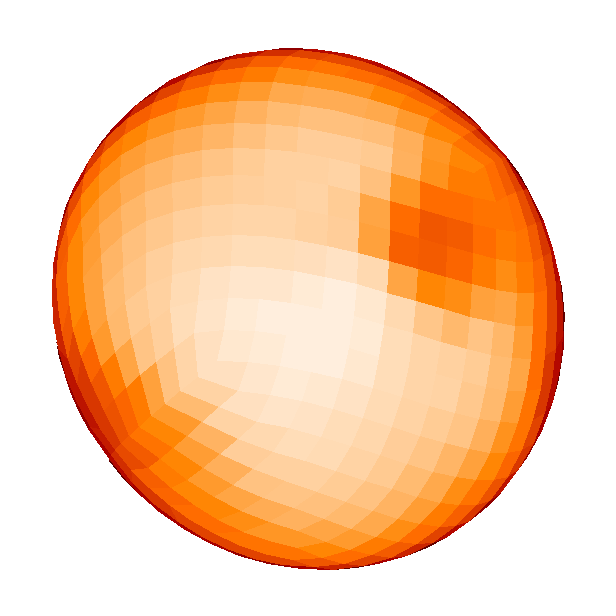 An animation of the rotating ζ And based on the observations of 2013 (Roettenbacher & Monnier).
An animation of the rotating ζ And based on the observations of 2013 (Roettenbacher & Monnier).
Older highlights
|
